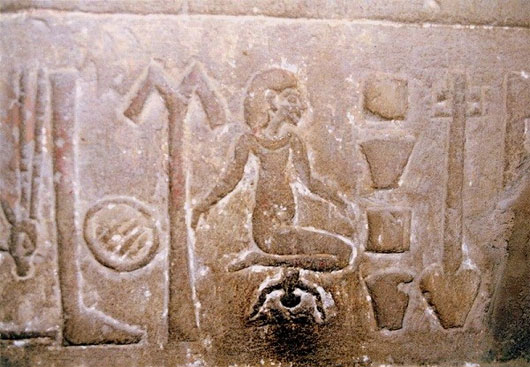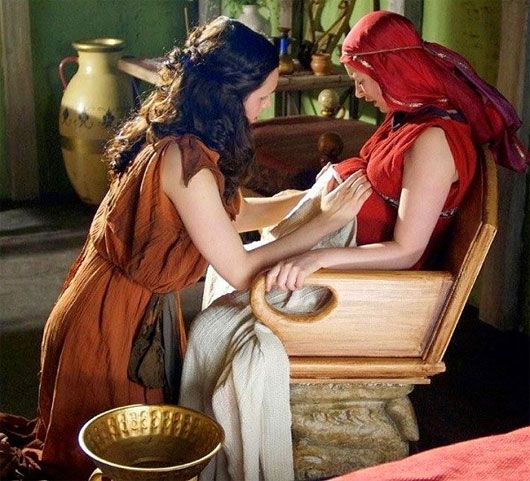The frightening 'crossover' story of old women
Understanding more about the hardship and difficulties when women are "outdated" in human history .
Being a mother is one of the most sacred vocation of women. But, throughout history, childbirth is one of the "hard to say" stories and rarely mentioned.
Even at a time, giving birth is no longer a happiness but a woman's nightmare. Let's explore interesting things about women's "travels" through each stage of history in the article below.
1. Ancient times
Ancient Egypt (12,000 BC - 332 BC) was an early and quite complete cognitive culture of human pregnancy. From a very early age, the Egyptians have drawn experiences about childbirth: women with big hips and big breasts will be more likely to give birth than others.
To help women give birth more favorably, they even invented a mysterious drink or a mixture of turmeric and beer rubbed on the mother's abdomen to increase intestinal motility.

Ancient image depicts the birth of an ancient Egyptian
However, the Egyptians did not have the concept of midwives. Simple childbirth is given to mothers who are experienced relatives or friends of the mother. When giving birth, Egyptian women must squat or kneel directly on the ground.

Recreate the scene of the birth of ancient Egyptians
At that time, there was no antiseptic or pain relief for women like today. In order to avoid illness for children, Egyptians often take the mother's blood at birth to rub on the newborn baby. For the mother, they often take Nile water to rub their backs and eat a rat because they think that will help their mother have more milk for them.
At this time, the method of giving birth to Westerners has many similarities with the Egyptians. However, they are more careful and meticulous in taking care of their newborn mother and baby.

The picture depicts the birth of a Roman woman
The Roman writer Soranus described the process of giving birth in the second century as follows: Pregnant women also give birth in squatting posture on a U-shaped chair.
Some of the tools to be prepared are olive oil, warm water, sponges, wool blankets, diapers, pillows, etc. Immediately after birth, babies are bathed with salt by the midwives, diluted in warm water. and apply olive oil to the skin to protect the skin.
2. Medieval times
The medieval period marked the dominance of feudalism in Eastern society as well as the rise of Christianity under the feudal lordship in the West. It is these social characteristics that inhibit the advanced development in medicine in general and in the birth of women in particular.
At that time, men are not allowed to be involved and involved in childbirth. In 1522, Hamburg doctor Wertt tried to disguise himself as a midwife who entered the room to find out how to give birth to a living being burned.
It is conceived that women are forced to suffer pain and suffering when having a new child in order to have God's will, so no pain relief measures have been devised and applied at this time.

Because of disguise, Hamburg doctor Wertt was burned alive
Basically, the method of giving birth at that time did not change much compared to the ancient period. Women give birth in dark rooms, blinds are closed and wear a lot of clothes and skirts for fear of embarrassment.
They can squat or lie while giving birth with the duty of being around the midwives. Babies are forbidden to be exposed to sunlight - which is thought to be harmful to babies. They will be breastfed for a long time, about 3 years old to wean. This is also considered as a natural contraceptive method, which relaxes the continuous delivery period of mothers.

However, the lack of antiseptic drugs along with blind faiths turned medieval birth into a nightmare for women. The rate of mothers who died at childbirth was 1-2%. Even at times, 20% of children in Europe cannot live through the fifth year of life because of illness problems at birth.

The advice of male doctors is only conjectural because they do not have direct contact with female patients
3. Modern times
The first phase of modern times saw the occurrence of postpartum fever. Because the sense of sanitizing hygiene for patients is too poor, many women have died because of childbirth in the XVII - XVIII century.
Later, the doctors also sought to overcome the drawback. Before birth, the mothers are cleaned the skin of the abdomen, thighs and genitals with warm water, soap, Lysol cleaning solution .

Portrait of James Young - the doctor opens a new era for women's birth
However, this chemical can cause burns and create pain for patients. In order to help them, doctors use lard to apply to the 'sensitive area' to increase smoothness when the patient 'runs out'. When forest sinks, people also arranged the sheets on the sides of the bed for patients to stick to, creating a certain comfort.
Things only really changed in the early nineteenth century with the introduction of anesthetic. In 1847, obstetrician James Young began introducing chloroform as an anesthetic that could be used in labor. In 1853, Queen Victoria was the first mother to use this drug when she gave birth to the eighth child, Prince Leopold.

The success of this case has opened a new turning point in women's fertility. Continuously in the early twentieth century, new types of analgesics, anesthesia were used in reproduction such as morphine, scopolamine, etc., helping to make the "overflows" easier and more comfortable like today.
- Nasal spray gel makes it easy for women to
- The numbers are frightening about the environment
- Mysterious world of people with schizophrenia
- Detect the origin of the story
- 6 interesting facts about ancient women that women themselves are surprised
- Detecting the frightening relationship between belly fat and cancer
- The truth about 'Living 200 years is even more frightening than death?'
- Why are women 'more wet' than men?
- The death coincides with scary
- Women need more sleep than men
- Why do women cry more than men?
- Attractive women find work easier
 'Fine laughs' - Scary and painful torture in ancient times
'Fine laughs' - Scary and painful torture in ancient times The sequence of numbers 142857 of the Egyptian pyramids is known as the strangest number in the world - Why?
The sequence of numbers 142857 of the Egyptian pyramids is known as the strangest number in the world - Why? History of the iron
History of the iron What is alum?
What is alum?